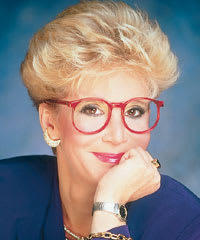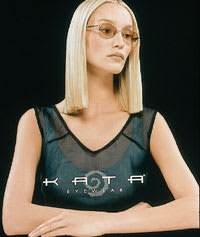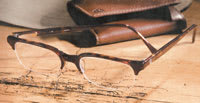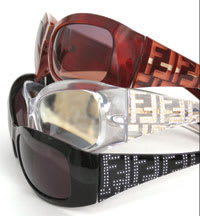feature
AS TIME GOES BY
During Eyecare Business' lifespan, the frames world has changed dramatically. Styles have developed, distribution chains have entered the playing field, and brands have put their mark on the market.
The following is a look at the styles, materials, and industry issues that have shaped the past 20 years of the ever-exciting frames
portion of the optical market.
1980's
In the age of the yuppie, greed was good and affluence was on the rise. Rebellion from the 60s and 70s was out and conspicuous consumption was the order of the day.
As Eyecare Business entered the picture in the second half of the decade, the branding machine was kicking into gear. Fashion designers introduced a total look, which provided everything from underwear to overcoats under one designer label.
Eyewear manufacturers jumped into the fray with partnerships from Giorgio Armani and Ralph Lauren.
When it came to style, the tortoise P-3 frame and its variants were the design staples, as were modifications on the aviator.
Adding to the eyewear mix for the decade was the entry of sports and performance eyewear.
Modeled in the field by professional athletes, skiing, golf, and water sport afficionados were tempted to opt for wrap styles for style as well as for protection.

|

|

|

|
| Left to right: Sally Jesse Raphael popularized red zyl frames on her TV talk show; eyewear for children was made available in the 80s; Titmus Childguard 1 and Childguard 11; Stevie Wonder in sunwear from Safilo on his "My Eyes Don't Cry" album; James Garner and Paul Newman (frame vendors unknown) hit the track in aviators | |||
1990's
Thanks to technology and manufacturing shifts, the 1990s translate into a decade of globalization. Shifting from domestic frame production, 90 percent of the frame products distributed in the U.S. in the '90s were imported, generally from Europe and Asia.
Japan's reputation for quality manufacturing was buffed thanks to craftsmanship with super-strong yet lightweight and hypoallergenic titanium frames. This material intrigued consumers but it took the bulk of the decade for manufacturers to successfully apply color and design elements to titanium. By the decade's end, titanium and various titanium alloys dominated the market, and metal mania expanded into stainless steel and other lightweight materials as well.
Production of frames in Korea, Hong Kong, and China, where production costs were more affordable, was also growing. Low production costs and
managed care's impact resulted in the proliferation in the market of lower-priced frame lines, referred to as value eyewear.
On the fashion side, the '90s opened with vintage styling. But color and plastics moved to the forefront by the middle of the decade. Oversized sunwear hits the scene in a rainbow of colors.
For ophthalmic eyewear, the look was small, thin, and plastic, made possible thanks to a new acetate formula developed by Mazzucchelli. The end of the century brought a new creativity to plastic frames as layered laminates provided an artistic touch on frames.

|

|

|
| Left to right: Tommy Lee Jones and Will Smith once again popularized Ray-Ban Wayfarer in "Men in Black;" eyeOta's Kata brand was a key player in the movement toward high-end styling in the 90s; lifestyle collections were a major trend in the 90s, like this Timberland style from REM Eyewear | ||
2000's
Rife with economic, political, and social uncertainty, this unfolding decade has already been tagged as the "Turbulent Two-Thousands." Still, the world marches on. Most notable is how the Internet permeates daily life with its use actually surpassing television viewing in 2004. Thus, the population becomes well accustomed to wireless networks, Google-ing, blogs, and downloading music at broadband speeds.
The eyewear industry follows suit with technology in frame materials, lenses, and even design. Oakley launched the Thump—a much-talked-about mp3/sunwear combo—and the Razrwire™, which combines Motorola wireless headphone technology into a pair of sunglasses. Smith Optics follows this lead with a similar concept with Plantronics.
The rise of extreme sports pushes frame manufacturers to deliver goods that are durable, performance-oriented, and style-driven. As a result, wrap styling in six- and eight-base curves comes onto the scene. This is truly the decade of the daredevil—even reality TV shows take on an "extreme" nature.
Eyewear gets a full body in styling that is oversized and embellished. Bling is in (thanks to celebs like Paris Hilton) and eyewear has the crystals, jewels, and supersized logos to prove it. Conversely, the rimless trend takes off this decade—minimalism is done just right. This direction opens the door for high-end lens treatments, finishes, and tints.
High-end eyewear also thrives in an optical retail marketplace that is truly changed forever by managed care. ECPs looking for a profitable niche find room in their assortments to trade up to a selection of higher-priced frames.

|

|

|

|

|
| Left to right: The future is now with eyewear that takes multitasking to a whole new level. Shown: Oakley's Thump mp3 player/sunglass; logos and bling became a look with appeal beyond the celebrity scene. Shown Marchon Fendi style 14; oversized wraps by Christian Roth for Charmant protect the eyes and create a cool smooth look; rimless eyewear takes center stage this decade with lightweight hingeless eyewear styles from Silhouette; celebs take on a greater role in setting eyewear trends and showing off the latest styles. Here, Mena Suvari in Christian Dior Mini Aviator frames from Sàfilo | ||||



